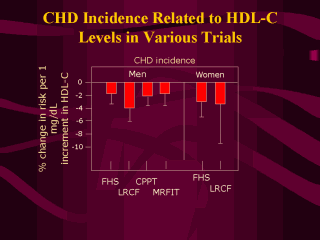| front |1 |2 |3 |4 |5 |6 |7 |8 |9 |10 |11 |12 |13 |14 |15 |16 |17 |18 |19 |20 |21 |22 |23 |24 |25 |26 |27 |28 |29 |review |
 |
95% confidence intervals (CIs) for
adjusted proportional hazards regression coefficients. FHS = Framingham Heart Study; LRCF = Lipid Research Clinics Prevalence Mortality Follow-up Study; CPPT = Lipid Research Clinics Coronary Primary Prevention Trial; MRFIT = Multiple Risk Factor Intervention Trial To determine whether the relationship between high-density lipoprotein cholesterol (HDL-C) and coronary heart disease (CHD) is independent of the influence of other risk factors, Gordon et al analyzed the relation between HDL-C and CHD incidence (adjusting for age, blood pressure, smoking, body mass index, and low-density lipoprotein cholesterol) in four American cardiovascular studies: the Framingham Heart Study (FHS), the Lipid Research Clinics Prevalence Mortality Follow-up Study (LRCF), the Lipid Research Clinics Coronary Primary Prevention Trial (CPPT), and the Multiple Risk Factor Intervention Trial (MRFIT).1 A 1-mg/dL increase in HDL-C was associated with a significant 2% decrease in CHD risk in men (FHS, CPPT, and MRFIT) and a 3% decrease in women (FHS). The regression coefficients for LRCF in this slide are based on CHD mortality because only fatal outcomes were documented in that study. Reference 1. Gordon DJ, Probstfield JL, Garrison RJ, et al. High-density lipoprotein cholesterol and cardiovascular disease: four prospective American studies. Circulation. 1989;79:8–15. |